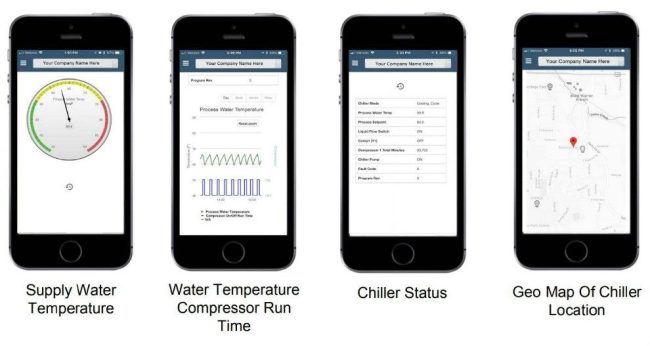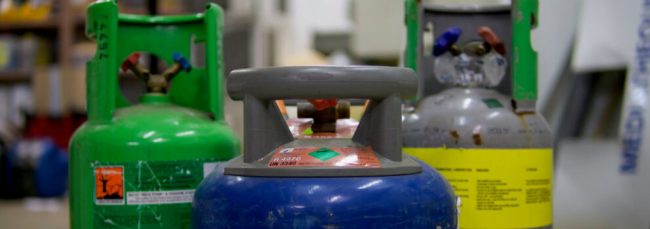
Industrial Chiller Maintenance Checklist & Preventive Maintenance

Many industrial processes generate significant quantities of heat, which must be dissipated as quickly as possible to prevent damage to sensitive equipment as well as prevent defects in the quality of finished products.
Industrial chillers are heat exchange machines that exert a cooling effect that helps to rid a process or machine of unwanted heat. An industrial chiller can be a significant purchase, so it is vital to understand how to maintain it to keep it operational for as long as possible.
Depending on the chiller types you are considering, the key features of this list may vary slightly. For example, the points on a water-cooled chiller maintenance checklist won’t necessarily apply to air-cooled chillers.
Below is a general checklist for chiller machine maintenance with items that apply air-cooled chillers and/or water-cooled chillers.
Ultimate Chiller Maintenance Checklist
- Inspection of all water inlets and outlets for leaks should be done routinely.
- All components of the compressor unit should be inspected, including checks for oil levels, leaks, vibrations, and operating temperature variations.
- Electrical contacts should be inspected and cleaned.
- Filter dryers should be checked, and dirty, old or faulty filters replaced entirely.
Tools & Equipment Needed for Maintenance
- Multimeter for electrical checks
- Coil cleaning kit or pressure washer
- Inspection mirrors and flashlight
- Refrigerant leak detector
- Glycol refractometer
- Thermometers and flow meters
Preventive Maintenance for Industrial Chillers
Here are a few tips for maintaining your industrial chillers below:
1. Maintain your Daily Logs
As basic as this may seem, maintaining a daily record of operating conditions, including pressure and temperature in the chiller unit, as well as fluid levels and flow rates, can help quickly predict the likelihood of future damage to the chiller machine. Keeping a chiller log sheet is advantageous as a pre-emptive chiller maintenance schedule can be structured before the onset of actual damage.
Make chiller preventive maintenance tasks easy with the Cold Shot Guardian™ predictive maintenance app. This tool helps eliminate unscheduled downtime by providing “real-time” chiller guardian app screenshot operational information through your WIFI, LAN, or even LTE connections.

2. Keep the Chiller Tubing Clean
The industrial chiller working principle is reliant on heat transfer to exert a cooling effect. In shell-and-tube and brazed-plate heat exchangers, an obstruction to the flow of cooling fluid through condenser tubes will significantly diminish the efficiency with which a chiller transfers heat.
Over time, corrosion can accumulate inside the chiller tubing and impede the removal of generated heat. Therefore, it is necessary to schedule and carry out regular quarterly or at least yearly cleaning of the chiller tubes.
3. Reduce the Temperature of the Condenser Water
Reducing the temperature of the water entering the condenser of an industrial chiller, significantly improves efficiency as it has to work less to exert its overall cooling effect. Although not recommended as standard practice, reducing the water temperature passing through the chiller’s condenser unit may serve as a temporary measure to overcome coil problems.
4. Inspect the Condenser Water Loops
Although all units Cold Shot Chillers manufactures are closed-loop chillers, some chiller condensers have water loops that utilize open cooling sources such as air-cooling towers. As a result of this environmental exposure, there is a tendency for the water to become contaminated with biological growths, corrosion, and scale, which could affect overall heat transfer and chiller efficiency.
Chilled water loops should be inspected at least yearly and treated to remove contaminants. Regularly inspect your chiller’s “Y” strainer and use an inline cartridge filter for additional protection.
Light should be visible through the condenser coil for dirt or airborne particle build-up. Check deep into the coils with a flashlight and, if dirty, clean as needed.
Always disconnect the power before cleaning and protect all electrical components from water and from water entering electrical conduit lines. Remove the covers of the chiller and use water or compressed air to blow back through the coil in the opposite direction of airflow. Avoid any damage to coil fins such as bending fins flat.
5. Monitor for Refrigerant Leaks
The rate of cooling of a chiller is dependent on the amount of refrigerant circulating through its compressor. Valve stems sometimes vibrate loose and will result in leaks. Refrigerant leaks from the compressor or the introduction of moisture into the system can also impact the cooling capacity of the chiller.
Checking for leaks and maintaining a proper level of refrigerant in the chiller’s compressor will ensure optimal performance.

6. Measure the Glycol Concentration
Protection of system components from freezing is critical, as freezing can occur from the external ambient or internal system temperatures.
The evaporator (or other heat exchanger) is the most susceptible component to freezing, even during normal operation. The fluid entering the evaporator must be capable of passing through without forming ice. Ice formation quickly restricts the flow, causing further freezing and eventual rupture.
The chilled fluid needs to have a freeze point that is well below any temperature that the chiller is capable of cooling.
7. Maintain an Optimal Chilled Water Flow Rate
The rate of flow of chilled water must be maintained to ensure satisfactory industrial cooling performance. Chillers need between 2.5 and 3 gallons per minute (GPM) per ton to provide efficient heat exchange. You will typically see a 10°F temperature exchange at 2.5 GPM per ton, and an 8°F temperature exchange at 3 GPM per ton.
8. Look Out for Non-condensables
Another significant aspect of chiller maintenance is keeping air and moisture out of your chiller system. As these elements can diminish chiller efficiency and increase energy consumption, it is vitally important that they are quickly purged from the condenser circulation.
9. Examine the Compressor Oil
Laboratory analysis of the oil from the compressor unit of a chiller should be done every year and changed according to recommendations from the analyzing lab. When oil changes are made, it is necessary for filters to be tested and replaced if faulty. However, oil analysis is limited to only centrifugal chiller operation and maintenance. Newer magnetic bearing frictionless chillers do not utilize oil.
10. Inspect Motors and Starting Mechanism
Routine sensor calibration, microprocessor control inspection, safety checks for electrical connections, wiring, and switchgear, are all recommended. Additionally, regular drive motor checks are required to keep chillers fully functional.
11. Install Variable Speed Drives
Chiller motors consume significant amounts of electricity when in use, which increases operation costs. Installation of variable frequency drives (VFDs) will offer energy savings as varying the motor speed matches motor efficiency to load, minimizing energy waste. These VSDs can allow chillers to operate normally even on emergency power generators.
Air-cooled Water Chillers Only
- Cooling coils must be inspected for distortion in fins, and signs of corrosion.
- Condenser fan inspections should be carried out with emphasis on bearings check for signs of wear, poor lubrication. Belts and couplings should also be checked and adjusted when necessary.
- Condenser coils should be inspected for leaks, corrosion, and areas of kinking or blockage.
- For air-cooled chillers, return air dampers should be inspected for optimal operation, calibration coupled with checks for bearings alignment and lubrication.
- Fresh air dampers for an air-cooled chiller system should be inspected in the same way as return air dampers.

Seasonal Maintenance Tips
Summer:
- Increase frequency of coil cleaning to counter pollen and debris buildup.
- Monitor condenser water temperature more closely due to higher ambient conditions.
- Confirm all fans are running efficiently to prevent overheating.
Winter:
- Ensure proper glycol concentration to prevent freezing.
- Monitor heat trace systems in exposed piping.
- Reduce airflow obstructions caused by ice/snow around outdoor units.
Cost of Neglecting Maintenance
| Issue | Potential Cost | Downtime Risk | Resolution Time |
|---|---|---|---|
| Coil Corrosion | $1,000 – $3,000 | High | 2–3 days |
| Compressor Failure | $5,000 – $15,000 | Very High | 1–2 weeks |
| Refrigerant Leaks | $300 – $1,200 | Medium | 1 day |
| Electrical Faults | $500 – $2,500 | Medium | 1–2 days |
Preventive maintenance not only reduces these costs but ensures longer equipment life and fewer production disruptions.
Cold Shot Chillers Has Your Industrial Chiller Needs Covered!
Cold Shot Chillers has been at the forefront of industrial chiller manufacturing and maintenance for over three decades. Our experienced and dedicated staff are always on hand to assist you with all industrial chiller needs.
Contact us online today for more information about how we can serve your process cooling needs.
